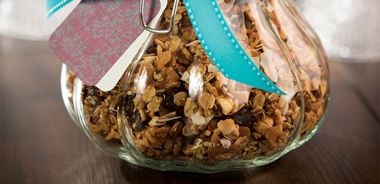Maple Hazelnut Granola

Who doesn’t love receiving from-scratch granola? Dried cherries, hazelnuts, and cacao nibs give this version a luxurious appeal and show recipients you truly care about helping them start the day in a healthy way.
3 cups (750 mL) rolled oats
1/2 cup (125 mL) walnuts, coarsely chopped
1/3 cup (80 mL) hemp hearts
1/2 tsp (2 mL) kosher salt
1/2 tsp (2 mL) cinnamon
1/2 tsp (2 mL) ground cardamom
1/2 cup (125 mL) pure maple syrup, preferably dark grade
1/2 cup (125 mL) coconut oil, melted
2 tsp (10 mL) vanilla extract
3/4 cup (180 mL) unsweetened coconut flakes
1/2 cup (125 mL) hazelnuts, halved
3/4 cup (180 mL) dried cherries or dried cranberries
1/4 cup (60 mL) cacao nibs
Preheat oven to 325 F (160 C).
In large bowl, toss together oats, walnuts, hemp hearts, salt, cinnamon, and cardamom. In separate bowl, stir together maple syrup, coconut oil, and vanilla. Add maple syrup mixture to oats and stir until everything is moist.
Turn mixture out onto parchment paper-lined baking sheet and spread out into an even layer. Bake for 15 minutes; remove pan from oven and stir in coconut flakes and hazelnuts. Return to oven and bake until granola is fragrant and golden, 18 to 20 minutes, stirring once halfway through. Be careful that the oats don’t burn. Stir in dried cherries and cacao nibs. Let cool completely and then divide among wide-mouth jars.
Makes enough for 3 to 4 gifts.
Each 1/2 cup (125 mL) serving contains: 384 calories; 6 g protein; 17 g total fat (13 g sat. fat, 0 g trans fat); 35 g total carbohydrates (13 g sugars, 8 g fibre); 103 mg sodium
source: "Love Bites", alive #386, December 2014





